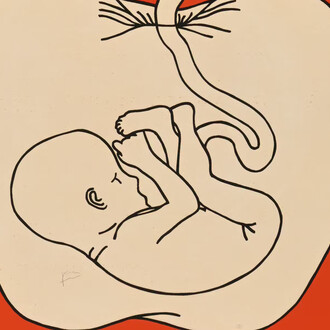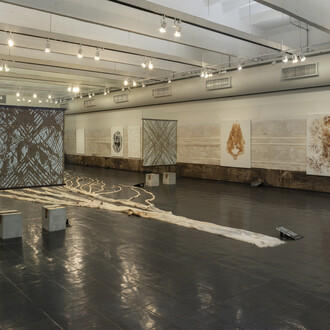Jorge Guinle Filho solidified his career and presence within our cultural fabric in the 1980s. He was an artist ahead of his time. His most significant artistic trajectory gained stature and solidity between 1980 and 1987—a brief period due to his untimely passing at the age of forty, yet marked by great intensity and a production accelerated by his contemporary drive. Born and deceased in New York, Guinle lived abroad for many years, but Rio de Janeiro was the city he chose to live in and where he produced his entire body of work. He was well aware of the dilemmas of art and closely followed emerging movements in Paris, New York, Brazil, and beyond, yet he remained in pursuit of his own artistic direction. His path reflects a commitment to painting, an unrestrained creative process, and a love for improvisation and the free flow of paint—qualities that are deeply present in his work. As he once stated, "Reaching harmony through paradoxes is what drives me."
He was an essential artist for Brazilian pictorial representation. The practice of painting shaped much of his daily life and his visual handwriting of the world. He maintained an absolute commitment to painting, employing traditional artistic methods par excellence, such as oil paint on canvas or the neutral support of paper. Guinle was part of a generation that sought to revitalize and uphold painting despite the dominance of conceptual art, pop art, and minimalism. His 1980s production remains, to this day, a key reference within the art circuit, standing as a significant aesthetic presence. In his work, he skillfully distilled the dynamism of cultivated styles—that is, modern and contemporary artistic movements that have kept history alive. As he put it, "To return to painting, it is necessary to make painting turn in circles."
Jorge Guinle’s work is characterized by a pluralism within his pictorial language. It embodies the diverse strands of predominant artistic tendencies, which he referred to as “the modern gods, the artists who shape one’s affective artistic background.” These influences permeated the logic and dynamism of his artistic production. Without adhering to a fixed aesthetic program, he maintained that “in painting, the human eye must glide across the entire canvas without being caught on any particular detail. I am someone who has borne the weight of the entire modern tradition, including the Fauvist movement.”
Where can Jorge Guinle’s works be placed within the art world? His paintings are inseparable from art history itself, challenging traditional boundaries between artistic movements. His practice resembled action painting, dissolving the divide between art and life. His canvases carry the successive traces of his actions, the fragments of his lived experiences.
Initially, Guinle’s paintings contained figurative references, but by the 1980s, they fluctuated between figuration and abstraction. His artistic production began to intertwine rapidly with various historical lineages, including German and Italian Expressionism and American painting. His process involved layering and unfolding a complex visual dynamic—one without apparent hierarchies or pauses, yet maintaining a frenetic, endless flow. Few and rare were the empty spaces on his canvases. Color played an intense role in his artistic universe. Painting, for Guinle, was a precise territory—an intricate repertoire deeply embedded in the historical fabric of art.
At the end of 1986, Guinle contracted pneumonia and received inconclusive results after an HIV test. Advised by doctors to undergo more detailed examinations in the United States, he traveled to New York in April 1987 and began treatment for AIDS. On May 9, he was admitted to Memorial Hospital, where he passed away on May 18, 1987. His final works were exhibited at the Grande Galeria of the Candido Mendes Cultural Center at Praça XV in December 1987. Further tributes followed in May 1988 at Galeria de Arte São Paulo and in July 1989 at Galeria Anna Maria Niemeyer, showcasing what were likely the last paintings he created before departing for New York. This final series was titled L'heure bleue / The blue hour, referencing a popular perfume from the 1930s. In these works, the pictorial process appears more diffuse, almost reluctant to reveal itself, due to the excessive use of diluents in the pigments. The visual fields became more serene, more subdued. Artist Fabio Miguez commented on these paintings: "Perhaps the most beautiful, where the depletion of painting, in a way, coincides with the depletion of life."
He was a remarkable interlocutor between new and preceding generations, leaving an indelible mark on Brazilian art history. He operated within an expansive, heterogeneous artistic territory, embracing new repertoires and possibilities. Throughout his life, he constantly questioned the dilemmas of painting—a persistent element, an object of desire. He remained deeply aware of the expansive nature of his artistic practice, executed through varied means and achieving extraordinary breadth. His work was uniquely his own—fluid, with a palette that floated in space, producing visually unexpected and striking plasticity. His brushstrokes, whether random or deliberate, reflected a pictorial system deeply rooted in the complex historiography of art.
During the New York winter of 1985-1986, he decided to spend a season with his mother, during which he created 14 large-scale paintings at Kaufman's Studio in Queens, as he was preparing an exhibition that was never realized. The first public unveiling of this extraordinary set of eight previously undiscovered paintings by the Simões de Assis gallery in the United States is part of the artist’s final works and anchors new angles of reflection on his legacy—its developments, continuities, or ruptures. These works were without a compass, never before found. I personally visited the studio in New York in search of them and found no trace. Simões de Assis was responsible for bringing these astonishing paintings to light, but its connection with Jorge Guinle’s work dates back a long time, to its inauguration on July 3, 1984, in Curitiba, where the artist was present and exhibited two paintings titled O minotauro and Interior atávico, accompanied by a critical text by Ronaldo Brito. The inaugural exhibition was a transgenerational group show featuring artists such as Alfredo Volpi, Tomie Ohtake, Arcangelo Ianelli, Ivald Granato, Hércules Barsotti, Rubens Gerchman, among others.
The act of painting is an infinite task—relentless and unending—yet seemingly created for the sensations of the present. Its secret codes are embedded in the complex inquiries of the pictorial system, unveiling new territories and opening pathways for fresh reflections within the fertile branches of art. To paint is to locate, within the realm of pictorial production, generative questions that reveal a thought process about painting itself. For Jorge Guinle, color holds a polysemic place—a language of apparent arbitrariness, wielded with unparalleled intensity and freedom, as if it were perpetually fresh paint.
These paintings radiate his continuous and fervent will to paint. They attest to the ebb and flow of painting as an exercise, with thick layers of oil and a dissonant chromatic repertoire that envelops us in its corporeal density—its pulsating elements constructing a vision of the world. His work sustains its identity while expanding his perpetual inquiry into painting, a process he pursued through diverse means to achieve an overwhelming mass, both as a method and an inevitable outcome. Saturated, discontinuous, vertiginous colors—combined with an intense visual pulse and the nervous energy of his gestures—define his language. A whirlwind of colors, dripping paint, and vigorous, vibrant brushstrokes extend in all directions. His canvases exude pictorial intelligence and visual erudition, transmitting immense plastic energy. Despite being dated 1986, they seem to exist in the present moment, maintaining their freshness intact. His works emanate something enduring, engaging us in an infinite conversation.
(Text by Vanda Klabin)















